Optimizing Incentive Policy of Energy-Efficiency Retrofit in Public Buildings: A Principal-Agent Model
Abstract
1. Introduction
2. Methodology
2.1. Principa–Agent Theory
2.2. Model Description
2.2.1. Players in the Principal–Agent Model
2.2.2. Benefits and Costs
2.2.3. Scenarios
2.2.4. Variables
3. Results
3.1. Preparatory Work
3.2. Results of Optimal Incentives in the Four Scenarios
4. Discussion
4.1. Scenario I Versus Scenario II
4.2. Scenario III versus Scenario IV
4.3. Government Incentive
4.4. Efforts of Owners and Tenants
4.5. Risk
5. Conclusions
Author Contributions
Funding
Appendix A
Appendix A1. Scenario I: Owner-Occupied and Owner-Benefited
Appendix A2. Scenario II: Owner-Occupied and Owner-Unbenefited
Appendix A3. Scenario III: Tenant-Occupied and Owner-Benefited
Appendix A4. Scenario IV: Tenant-Occupied and Owner-Unbenefited
References
- Hong, J.; Shen, G.Q.; Feng, Y.; Lau, W.S.-T.; Mao, C. Greenhouse gas emissions during the construction phase of a building: A case study in China. J. Clean. Prod. 2015, 103, 249–259. [Google Scholar] [CrossRef]
- THUBERC. Annual Report on China Building Energy Efficiency; China Building Industry Press: Hong Kong, China, 2007. [Google Scholar]
- Trust, C. Low Carbon Refurbishment of Buildings—A Guide to Achieving Carbon Savings from Refurbishment of Non-Domestic Buildings; Carbon Trust: London, UK, 2008. [Google Scholar]
- Xing, J.C.; Ren, P.; Ling, J.H. Analysis of energy efficiency retrofit scheme for hotel buildings using eQuest software: A case study from Tianjin, China. Energy Build. 2015, 87, 14–24. [Google Scholar] [CrossRef]
- Son, H.; Kim, C. Evolutionary many-objective optimization for retrofit planning in public buildings: A comparative study. J. Clean. Prod. 2018, 190, 403–410. [Google Scholar] [CrossRef]
- Liu, Q.B.; Ren, J. Research on technology clusters and the energy efficiency of energy-saving retrofits of existing office buildings in different climatic regions. Energy Sustain. Soc. 2018, 8, 24. [Google Scholar] [CrossRef]
- Shahrokni, H.; Levihn, F.; Brandt, N. Big meter data analysis of the energy efficiency potential in Stockholm’s building stock. Energy Build. 2014, 78, 153–164. [Google Scholar] [CrossRef]
- Hoyo-Montano, J.A.; Valencia-Palomo, G.; Galaz-Bustamante, R.A.; Garcia-Barrientos, A.; Espejel-Blanco, D.F. Environmental Impacts of Energy Saving Actions in an Academic Building. Sustainability 2019, 11, 989. [Google Scholar] [CrossRef]
- Martiskainen, M.; Kivimaa, P. Role of knowledge and policies as drivers for low-energy housing: Case studies from the United Kingdom. J. Clean. Prod. 2019, 215, 1402–1414. [Google Scholar] [CrossRef]
- Alam, M.; Zou, P.X.W.; Stewart, R.A.; Bertone, E.; Sahin, O.; Buntine, C.; Marshall, C. Government championed strategies to overcome the barriers to public building energy efficiency retrofit projects. Sustain. Cities Soc. 2019, 44, 56–69. [Google Scholar] [CrossRef]
- Pombo, O.; Rivela, B.; Neila, J. Life cycle thinking toward sustainable development policy-making: The case of energy retrofits. J. Clean. Prod. 2019, 206, 267–281. [Google Scholar] [CrossRef]
- Zhou, N.; McNeil, M.; Levine, M. Assessment of building energy-saving policies and programs in China during the 11th Five-Year Plan. Energy Effic. 2012, 5, 51–64. [Google Scholar] [CrossRef][Green Version]
- Li, J.; Shui, B. A comprehensive analysis of building energy efficiency policies in China: Status quo and development perspective. J. Clean. Prod. 2015, 90, 326–344. [Google Scholar] [CrossRef]
- Hou, J.; Liu, Y.; Wu, Y.; Zhou, N.; Feng, W. Comparative study of commercial building energy-efficiency retrofit policies in four pilot cities in China. Energy Policy 2016, 88, 204–215. [Google Scholar] [CrossRef]
- Ali, A.S.; Rahmat, I.; Hassan, H. Involvement of key design participants in refurbishment design process. Facilities 2008, 26, 389–400. [Google Scholar]
- Stiess, I.; Dunkelberg, E. Objectives, barriers and occasions for energy efficient refurbishment by private homeowners. J. Clean. Prod. 2013, 48, 250–259. [Google Scholar] [CrossRef]
- Lapinski, A.R.; Horman, M.J.; Riley, D.R. Lean processes for sustainable project delivery. J. Constr. Eng. Manag. 2006, 132, 1083–1091. [Google Scholar] [CrossRef]
- Kasivisvanathan, H.; Ng, R.T.L.; Tay, D.H.S.; Ng, D.K.S. Fuzzy optimisation for retrofitting a palm oil mill into a sustainable palm oil-based integrated biorefinery. Chem. Eng. J. 2012, 200, 694–709. [Google Scholar] [CrossRef]
- Davies, P.; Osmani, M. Low carbon housing refurbishment challenges and incentives: Architects’ perspectives. Build. Environ. 2011, 46, 1691–1698. [Google Scholar] [CrossRef]
- Korkmaz, S.; Messner, J.I.; Riley, D.R.; Magent, C. High-performance green building design process modeling and integrated use of visualization tools. J. Archit. Eng. 2010, 16, 37–45. [Google Scholar] [CrossRef]
- Bertone, E.; Sahin, O.; Stewart, R.A.; Zou, P.X.W.; Alam, M.; Hampson, K.; Blair, E. Role of financial mechanisms for accelerating the rate of water and energy efficiency retrofits in Australian public buildings: Hybrid Bayesian Network and System Dynamics modelling approach. Appl. Energy 2018, 210, 409–419. [Google Scholar] [CrossRef]
- Liu, W.L.; Zhang, J.Y.; Bluemling, B.; Mol, A.P.J.; Wang, C. Public participation in energy saving retrofitting of residential buildings in China. Appl. Energy 2015, 147, 287–296. [Google Scholar] [CrossRef]
- Kerr, N.; Gouldson, A.; Barrett, J. The rationale for energy efficiency policy: Assessing the recognition of the multiple benefits of energy efficiency retrofit policy. Energy Policy 2017, 106, 212–221. [Google Scholar] [CrossRef]
- Liu, Y.M.; Liu, T.T.; Ye, S.D.; Liu, Y.S. Cost-benefit analysis for Energy Efficiency Retrofit of existing buildings: A case study in China. J. Clean. Prod. 2018, 177, 493–506. [Google Scholar] [CrossRef]
- Camprubi, L.; Malmusi, D.; Mehdipanah, R.; Palencia, L.; Molnar, A.; Muntaner, C.; Borrell, C. Facade insulation retrofitting policy implementation process and its effects on health equity determinants: A realist review. Energy Policy 2016, 91, 304–314. [Google Scholar] [CrossRef]
- Sebi, C.; Nadel, S.; Schlomann, B.; Steinbach, J. Policy strategies for achieving large long-term savings from retrofitting existing buildings. Energy Effic. 2019, 12, 89–105. [Google Scholar] [CrossRef]
- Achtnicht, M.; Madlener, R. Factors influencing German house owners’ preferences on energy retrofits. Energy Policy 2014, 68, 254–263. [Google Scholar] [CrossRef]
- Liang, X.; Yu, T.; Hong, J.; Shen, G.Q. Making incentive policies more effective: An agent-based model for energy-efficiency retrofit in China. Energy Policy 2019, 126, 177–189. [Google Scholar] [CrossRef]
- Liang, X.; Peng, Y.; Shen, G.Q. A game theory based analysis of decision making for green retrofit under different occupancy types. J. Clean. Prod. 2016, 137, 1300–1312. [Google Scholar] [CrossRef]
- Macho-Stadler, I.; Pérez-Castrillo, D. Principal-Agent Models; Springer: New York, NY, USA, 2012; pp. 265–281. [Google Scholar]
- Ng, S.T.; Wong, J.M.W.; Skitmore, S.; Veronika, A. Carbon dioxide reduction in the building life cycle: A critical review. Proc. Inst. Civ. Eng. Eng. Sustain. 2012, 165, 281–292. [Google Scholar] [CrossRef]
- IEA. Mind the Gap: Quantifying Principal-Agent Problems in Energy Efficiency; IEA: Paris, France, 2007. [Google Scholar]
- Blumstein, C. Program evaluation and incentives for administrators of energy-efficiency programs: Can evaluation solve the principal/agent problem? Energy Policy 2010, 38, 6232–6239. [Google Scholar] [CrossRef]
- Miller, E.; Buys, L. Retrofitting commercial office buildings for sustainability: Tenants’ perspectives. J. Prop. Invest. Financ. 2008, 26, 552–561. [Google Scholar] [CrossRef]
- Juan, Y.K.; Kim, J.H.; Roper, K.; Castro-Lacouture, D. GA-based decision support system for housing condition assessment and refurbishment strategies. Autom. Constr. 2009, 18, 394–401. [Google Scholar] [CrossRef]
- Kaklauskas, A.; Zavadskas, E.K.; Galiniene, B. A building’s refurbishment knowledge-based decision support system. Int. J. Environ. Pollut. 2008, 35, 237–249. [Google Scholar] [CrossRef]
- Fuerst, F.; McAllister, P. Green Noise or Green Value? Measuring the Effects of Environmental Certification on Office Values. Real Estate Econ. 2011, 39, 45–69. [Google Scholar] [CrossRef]
- Thomas, L.E. Evaluating design strategies, performance and occupant satisfaction: A low carbon office refurbishment. Build. Res. Inf. 2010, 38, 610–624. [Google Scholar] [CrossRef]
- Caccavelli, D.; Gugerli, H. TOBUS–A European diagnosis and decision-making tool for office building upgrading. Energy Build. 2002, 34, 113–119. [Google Scholar] [CrossRef]
- Menassa, C.C.; Baer, B. A framework to assess the role of stakeholders in sustainable building retrofit decisions. Sustain. Cities Soc. 2014, 10, 207–221. [Google Scholar] [CrossRef]
- Fudenberg, D.; Tirole, J. Game Theory; MIT Press: Cambridge, MA, USA, 1991; Volume 393. [Google Scholar]
- Xiao, L. 81 Occupiers Raised 16 Million to Adopt Green Retrofit in Shenzhen International Trade Center. Available online: http://www.chinadaily.com.cn/hqcj/xfly/2015-03-26/content_13438376.html (accessed on 24 May 2019). (In Chinese).
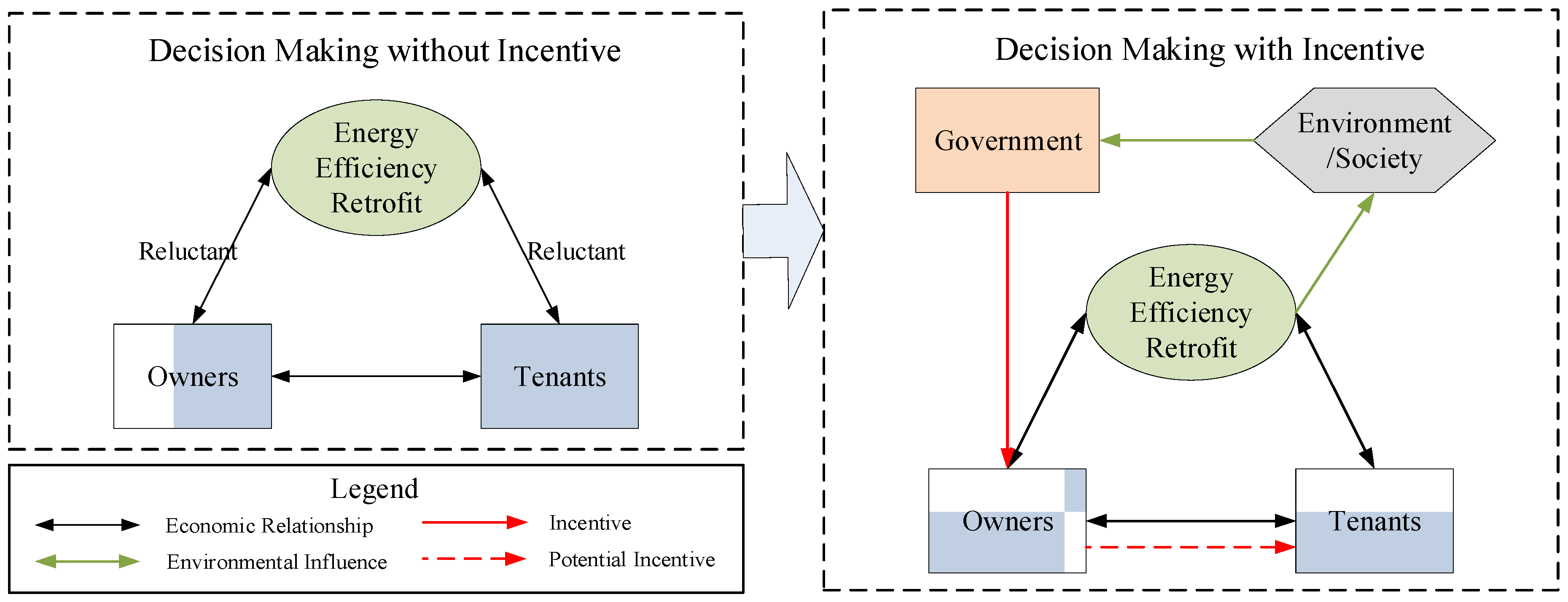
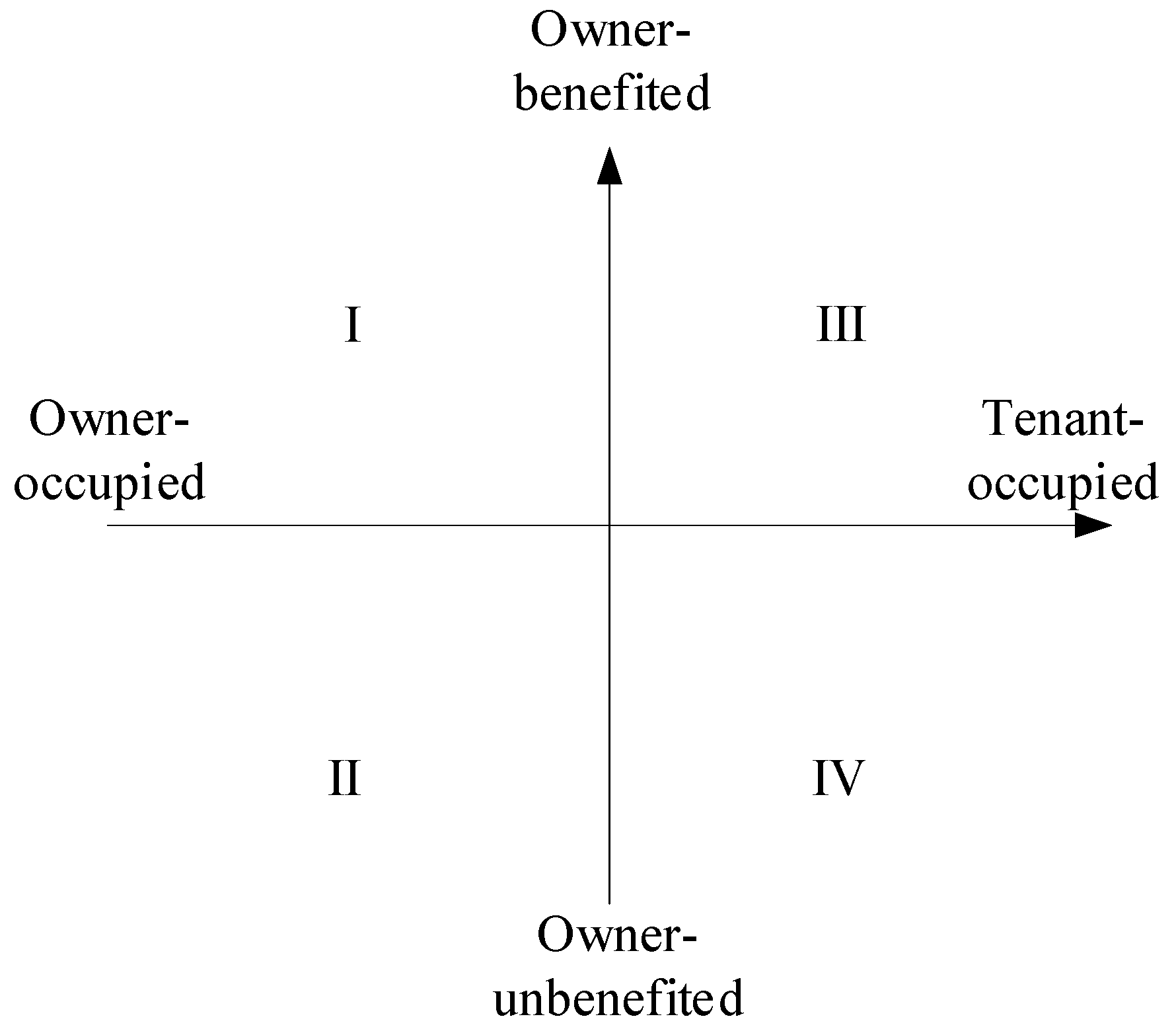
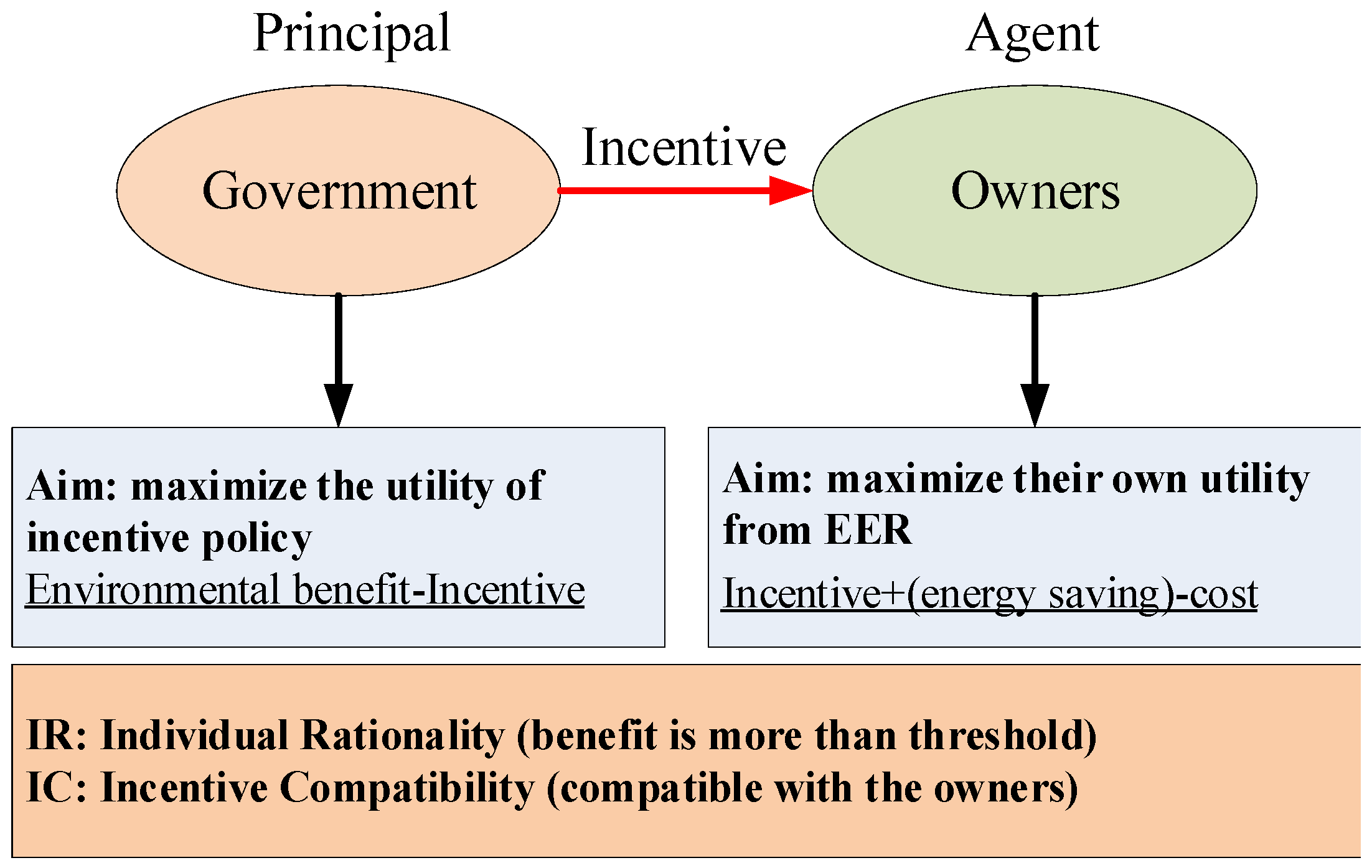
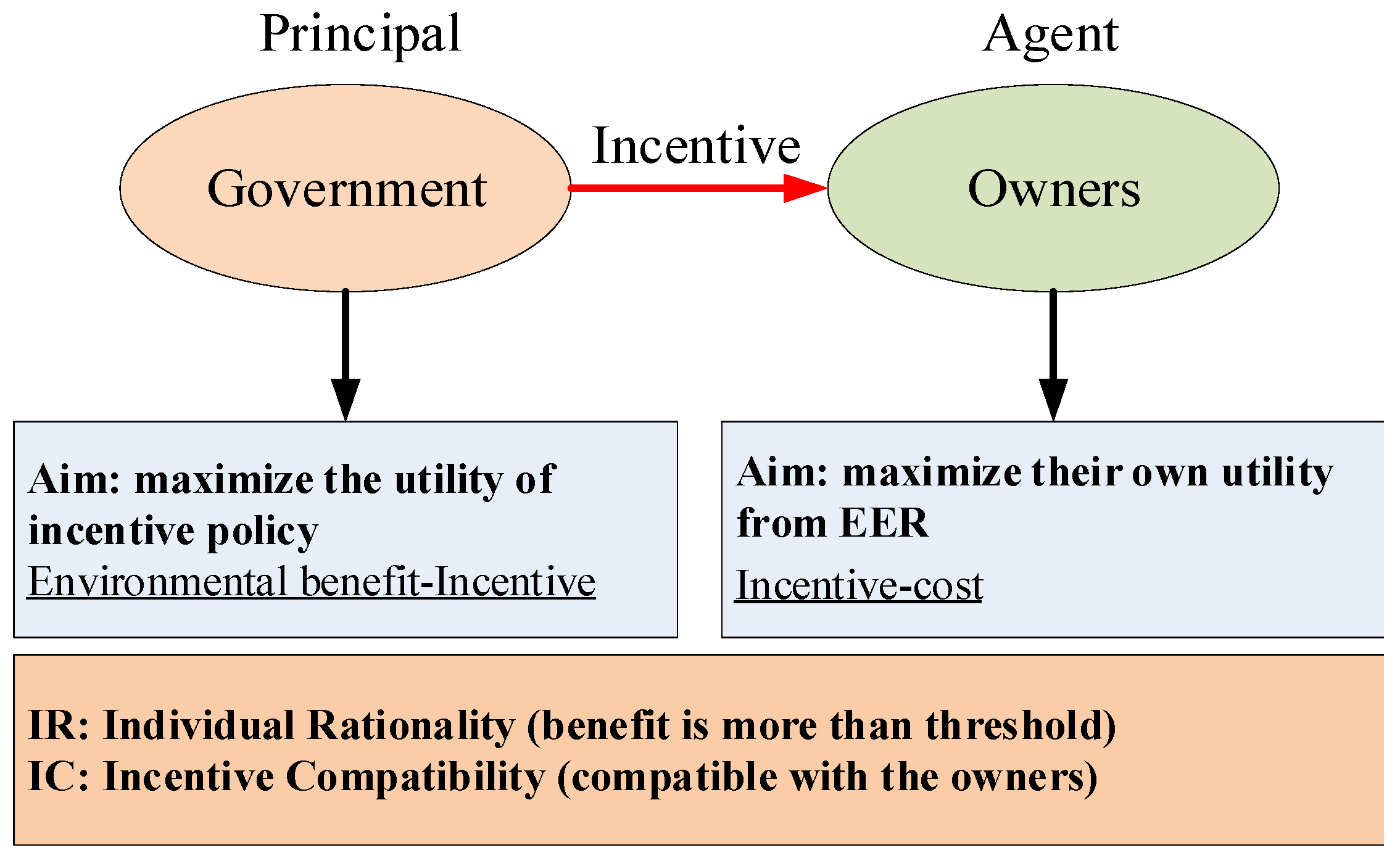
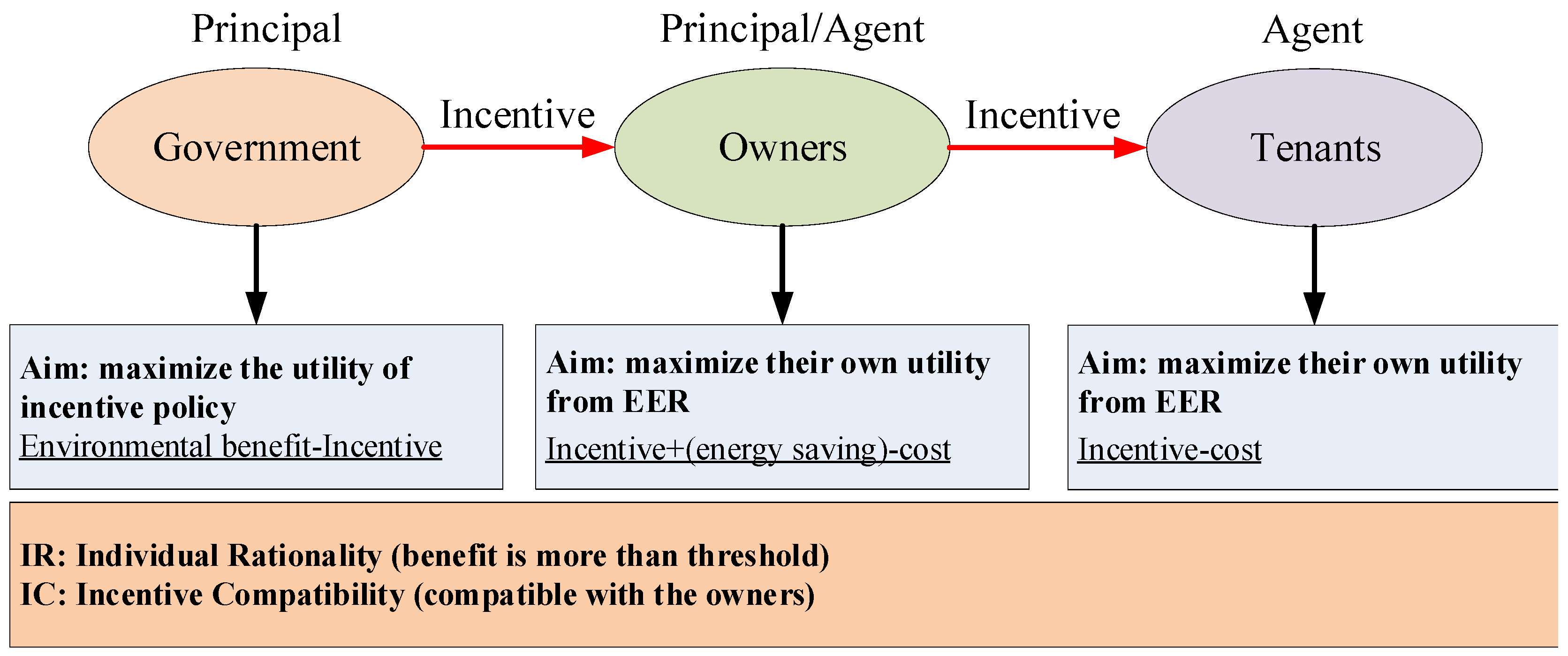
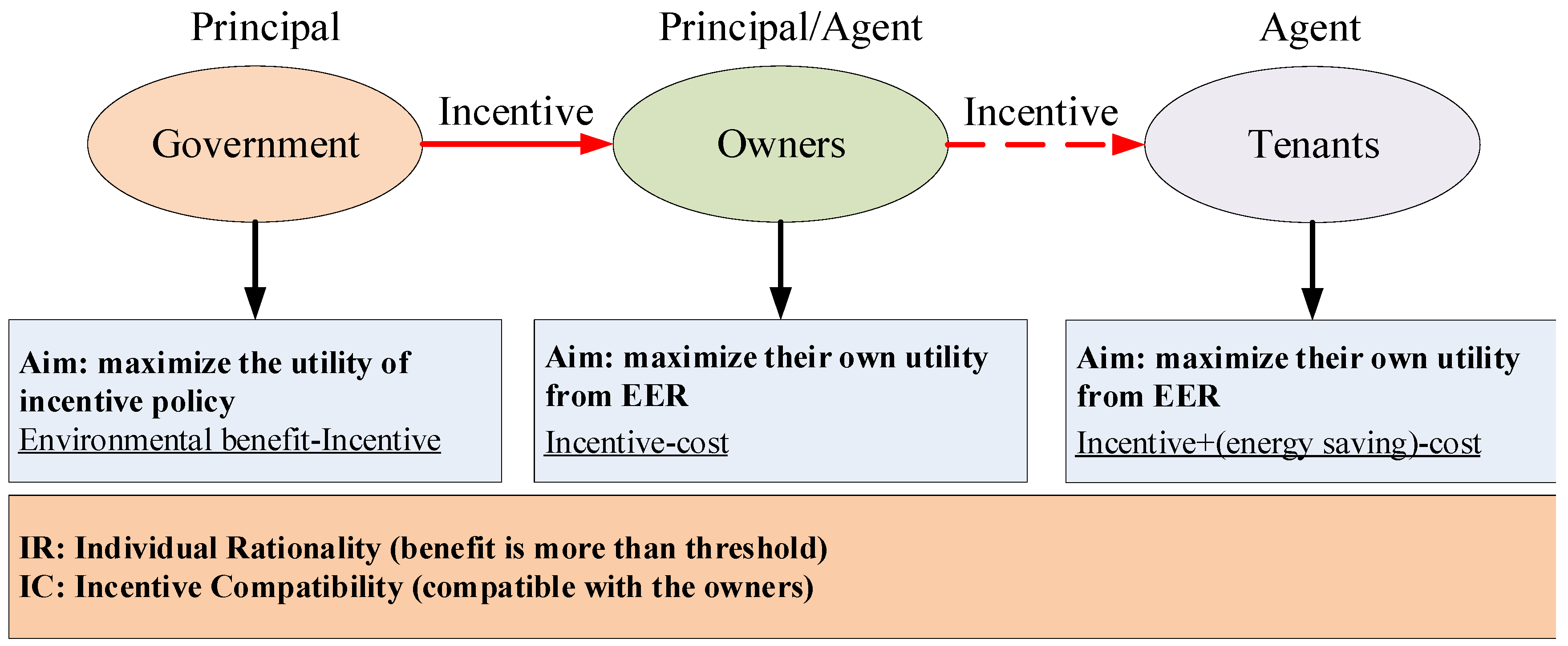
| Stakeholders | Benefits | Costs |
|---|---|---|
| Owners | Economic benefits from retrofit | Cost of EER |
| Incentives from government | Incentives to tenants (optional) | |
| Tenants | Economic benefits from retrofit | Cost of EER |
| Incentives from owners (optional) | ||
| Government | Economic and social benefit | Incentives to owners |
| Category | Variable | Definition |
|---|---|---|
| Owner | owners’ effort to EER | |
| cost of owners’ effort to EER | ||
| owners’ income from EER | ||
| incentive of owner to tenant | ||
| utility function of owners | ||
| Tenant | tenants’ effort to EER | |
| cost of tenants’ effort to EER | ||
| tenants’ income from EER | ||
| utility function of tenant | ||
| Government | incentive of government to owners | |
| utility function of government | ||
| Environment | exogenous uncertainty probability distribution, mean is 0, variance is | |
| coefficient of economic benefit from EER, | ||
| coefficient of environmental benefit from EER, | ||
| benefit of EER, + | ||
| economic benefit of EER | ||
| environmental benefit of EER | ||
| Intermediate variable | Coefficient of the incentive to owners | |
| Coefficient of the incentive to tenants | ||
| Coefficient of owner’s cost | ||
| Coefficient of tenant’s cost |
| Scenario I | Scenario II | Scenario III | Scenario IV | |
|---|---|---|---|---|
| NA | NA |
| I | II | III | IV | |
|---|---|---|---|---|
| NA | NA | |||
| NA | NA |
| I | II | III | IV | |
|---|---|---|---|---|
| 1 | 1 | |||
| NA | NA | |||
| NA | NA |
© 2019 by the authors. Licensee MDPI, Basel, Switzerland. This article is an open access article distributed under the terms and conditions of the Creative Commons Attribution (CC BY) license (http://creativecommons.org/licenses/by/4.0/).
Share and Cite
Liang, X.; Shen, G.Q.; Guo, L. Optimizing Incentive Policy of Energy-Efficiency Retrofit in Public Buildings: A Principal-Agent Model. Sustainability 2019, 11, 3442. https://doi.org/10.3390/su11123442
Liang X, Shen GQ, Guo L. Optimizing Incentive Policy of Energy-Efficiency Retrofit in Public Buildings: A Principal-Agent Model. Sustainability. 2019; 11(12):3442. https://doi.org/10.3390/su11123442
Chicago/Turabian StyleLiang, Xin, Geoffrey Qiping Shen, and Li Guo. 2019. "Optimizing Incentive Policy of Energy-Efficiency Retrofit in Public Buildings: A Principal-Agent Model" Sustainability 11, no. 12: 3442. https://doi.org/10.3390/su11123442
APA StyleLiang, X., Shen, G. Q., & Guo, L. (2019). Optimizing Incentive Policy of Energy-Efficiency Retrofit in Public Buildings: A Principal-Agent Model. Sustainability, 11(12), 3442. https://doi.org/10.3390/su11123442






